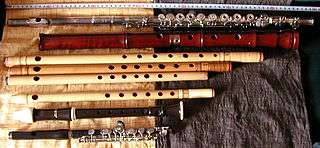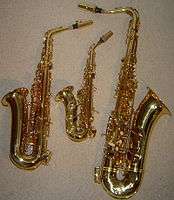Aerophone

An aerophone is any musical instrument that produces sound primarily by causing a body of air to vibrate,[1] without the use of strings or membranes, and without the vibration of the instrument itself adding considerably to the sound.[2] Aerophones categorically comprise "the largest and most complex group of instruments in the Americas".[3]
Overview
Aerophones are one of the four main classes of instruments in the original Hornbostel–Sachs system of musical instrument classification, which further classifies aerophones by whether or not the vibrating air is contained within the instrument. The first class (41) includes instruments which, when played, do not contain the vibrating air. The bullroarer is one example. These are called free aerophones. This class includes (412.13) free reed instruments, such as the harmonica, but also many instruments unlikely to be called wind instruments at all by most people, such as sirens and whips. The second class (42) includes instruments which contain the vibrating air when being played. This class includes almost all instruments generally called wind instruments — including the didgeridoo, (423) brass instruments (e.g., trumpet,[4] french horn, baritone horn, tuba), and (421 & 422) woodwind instruments (e.g., oboe,[4] flute,[4] saxophone, clarinet[4]).[5]
Additionally, very loud sounds can be made by explosions directed into, or being detonated inside of resonant cavities. Detonations inside the calliope (and steam whistle), as well as the pyrophone might thus be considered as class 42 instruments, despite the fact that the "wind" or "air" may be steam or an air-fuel mixture.
History

Identifying the origin of the aerophone is difficult, though it is believed that Americans and their descendants developed the largest diversity of aerophones, and they are understood to have been the major non-vocal, melodic instruments of Native America.[6] Archaeological studies have found examples of globular flutes in ancient Mexico, Colombia and Peru, and multiple tubular flutes were common among the Maya and Aztec. The use of shells of Conches as an aerophone have also been found to be prevalent in areas such as Central America and Peru.[7]
Examples of aerophone type instruments in China can be dated back to the Neolithic period. Fragments of bone flutes can be found at the burial sites of the Jiahu settlements of ancient China, and they represent some of the earliest known examples of playable instruments. The instruments were typically carved from the wing bone of the red-crowned crane, and had five to eight holes. The flutes were efficient enough to produce sound in a nearly accurate octave, and are thought to have been used ceremonially or for ritualistic purposes.[8][9] Examples of flutes made out of bamboo in China date back to 2nd Century BC. These flutes were known as Dizi's or simply Di (笛) and typically had 6 holes for playing melodies that were framed by scale-modes.[10]
Flutes including the famous Bansuri, have been an integral part of Indian classical music since 1500 BC. A major deity of Hinduism, Krishna, has been associated with the flute.[11][12] Some early flutes were made out of tibias (shin bones). The flute has also always been an essential part of Indian culture and mythology,[13] and the cross flute is believed, by several accounts, to originate in India[14][15] as Indian literature from 1500 BCE has made vague references to the cross flute.[16]
Types
Free
Free aerophones are instruments where the vibrating air is not enclosed by the instrument itself.
Displacement
The air-stream meets a sharp edge, or a sharp edge is moved through the air.
Interruptive
The air-stream is interrupted periodically.
Plosive
Occasionally called "percussive aerophones", plosive aerophones are sounded by percussion caused by a single compression and release of air.[17] An example of a plosive aerophone is the "scraper flute" which has tubes with ridged or serrated edges so that they can be scraped with a rod to produce sound.[18][19]
Non-free
Non-free aerophones are instruments where the vibrating air is contained within the instrument. Often called wind instruments, they are typically divided into two categories; Woodwind and Brass. It is widely accepted that wind instruments are not classified on the material from which they are made, as a woodwind instrument does not need to be made of wood, nor a brass instrument made of brass. Woodwind instruments are often made with wood, metal, glass or ivory and include the flute, oboe, clarinet, recorder and the saxophone. Brass instruments are often made with silver, copper, ivory, horn, or even wood and include the trumpet, cornet, horn, trombone and the tuba.[20]
Flute
A flute is a type of aerophone, as is the Eunuch flute, also referred to as a mirliton.[4] A flute is an aerophone or reedless wind instrument that produces its sound from the flow of air across an opening. According to the instrument classification of Hornbostel–Sachs, flutes are categorized as edge-blown aerophones. Aside from the voice, flutes are the earliest known musical instruments. A number of flutes dating to about 43,000 to 35,000 years ago have been found in the Swabian Alb region of Germany. These flutes demonstrate that a developed musical tradition existed from the earliest period of modern human presence in Europe.[21][22]
- Flute aerophone examples
-

A Carnatic eight-holed bamboo flute
-
An eight-holed classical Indian bamboo flute.
-

Example of a Eunuch flute
Reed
A reed aerophone is a musical instrument that produces sound by the player's breath being directed against a lamella or pair of lamellae which periodically interrupt the airflow and cause the air to be set in motion.
- Reed aerophone examples
-

A bassoon
-

A duduk
-

Several oboes
-

Saxophones – from left to right, an E♭ alto saxophone, a curved B♭ soprano saxophone, and a B♭ tenor saxophone
Brass
A brass aerophone is a musical instrument that produces sound by sympathetic vibration of air in a tubular resonator in sympathy with the vibration of the player's lips. Brass instruments are also called labrosones, literally meaning "lip-vibrated instruments".[23] There are several factors involved in producing different pitches on a brass instrument. Slides, valves, crooks, or keys are used to change vibratory length of tubing, thus changing the available harmonic series, while the player's embouchure, lip tension and air flow serve to select the specific harmonic produced from the available series.
- Brass aerophone examples
-

An alto horn is a type of brass instrument and aerophone.
-

Trumpet in C
See also
References
- ↑ Randel, D.M. (1999). The Harvard Concise Dictionary of Music and Musicians. Harvard University Press reference library. Belknap Press. p. 12. ISBN 978-0-674-00084-1.
- ↑ "aerophone — OnMusic Dictionary". Connect for Education Inc. December 4, 2014. Retrieved December 4, 2014.
- ↑ Nettl, B.; Miller, T.E.; Stone, R.M.; Williams, S.; Porter, J.; Rice, T. (1998). The Garland Encyclopedia of World Music: Southeast Asia. Garland reference library of the humanities ; v. 1169 (v. 8), 1191 (v. 5), 1193 (v. 2). Garland Pub. pp. 28–30. ISBN 978-0-8240-6040-4.
- 1 2 3 4 5 Nzewi, M.; Nzewi, O. (2007). A Contemporary Study of Musical Arts: Informed by African Indigenous Knowledge Systems. A Contemporary Study of Musical Arts: Informed by African Indigenous Knowledge Systems. Centre for Indigenous Instrumental African Music and Dance (Ciimda). pp. 98–106. ISBN 978-1-920051-62-4.
- ↑ von Hornbostel, Erich M.; Sachs, Curt (1914). "Abhandlungen und Vorträge. Systematik der Musikinstrumente. Ein Versuch.". Zeitschrift für Ethnologie (in German). 46. Berliner Gesellschaft für Anthropologie, Ethnologie und Urgeschichte. pp. 582–590. Retrieved April 12, 2015.
- ↑ Malena Kuss. Music in Latin America and the Caribbean: an encyclopedic history. University of Texas Press. p. 262. ISBN 978-0-292-78840-4.
- ↑ Dale Olsen; Daniel Sheehy (17 December 2007). The Garland Handbook of Latin American Music. Routledge. pp. 42–43. ISBN 978-1-135-90008-3.
- ↑ Jiahu (ca. 7000–5700 B.C.)
- ↑ "Brookhaven Lab Expert Helps Date Flute Thought to be Oldest Playable Musical Instrument". Brookhaven National Laboratory.
- ↑ Howard L. Goodman (2010). Xun Xu and the Politics of Precision in Third-Century Ad China. BRILL. pp. 225–226. ISBN 90-04-18337-X.
- ↑ "Bansuri Bamboo Flute". Brindavan Gurukul.
- ↑ Leifer, Lyon (2005). How to Play the Bansuri: A Manual for Self-Instruction Based on the Teaching of Devendra Murdeshwar. Rasa Music Co. ISBN 0-9766219-0-8.
- ↑ Hoiberg, Dale; Ramchandani, Indu (2000). Students' Britannica India. Mumbai: Popular Prakashan. p. 125. ISBN 0-85229-760-2.
- ↑ Chaturvedi, Mamta (2001). How to Play Flute & Shehnai. New Delhi: Diamond Pocket Books (P) Ltd. p. 7. ISBN 81-288-1476-1.
- ↑ Morse, Constance (1968). Music and Music-makers. New Hampshire: Ayer Publishing. p. 7. ISBN 0-8369-0724-8.
- ↑ Arvey, Verna (2007). Choreographic Music for the Dance. London: Read Country Books. p. 36. ISBN 1-4067-5847-7.
- ↑ Hopkin, Bart (1996). Musical Instrument Design: Practical Information for Instrument Making. See Sharp Press. p. 85. ISBN 978-1-884365-08-9.
- ↑ Bart Hopkin. "Scraper Flutes". Retrieved 29 April 2015.
- ↑ Bart Hopkin (1 January 1996). Musical Instrument Design: Practical Information for Instrument Making. See Sharp Press. p. 86. ISBN 978-1-884365-08-9.
- ↑ Adam Carse (2002). Musical Wind Instruments. Courier Corporation. pp. 1–2. ISBN 978-0-486-42422-4.
- ↑ Wilford, John N. (June 24, 2009). "Flutes Offer Clues to Stone-Age Music". Nature. 459 (7244): 248–52. Bibcode:2009Natur.459..248C. doi:10.1038/nature07995. PMID 19444215. Lay summary – The New York Times.. Citation on p. 248.
- ↑ Higham, Thomas; Basell, Laura; Jacobi, Roger; Wood, Rachel; Ramsey, Christopher Bronk; Conard, Nicholas J. (2012). "Τesting models for the beginnings of the Aurignacian and the advent of figurative art and music: The radiocarbon chronology of Geißenklösterle". Journal of Human Evolution. 62 (6): 664–76. doi:10.1016/j.jhevol.2012.03.003. PMID 22575323.
- ↑ Baines, Anthony (1993). Brass instruments: their history and development. Dover Publications. p. 300. ISBN 0-486-27574-4.
Further reading
| Wikimedia Commons has media related to Aerophone. |
| Look up aerophone in Wiktionary, the free dictionary. |
| Wikisource has original text related to this article: |
- Burgh, T.W. (2006). Listening to the Artifacts: Music Culture in Ancient Palestine. Bloomsbury Academic. pp. 28–29. ISBN 978-0-567-02552-4.
Hornbostel–Sachs system | |||||||||||||||
|---|---|---|---|---|---|---|---|---|---|---|---|---|---|---|---|
| |||||||||||||||
| |||||||||||||||
| |||||||||||||||
| |||||||||||||||
| |||||||||||||||
